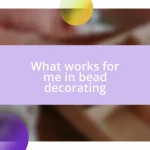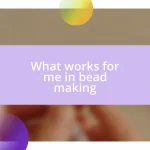Key takeaways:
- The right lampworking accessories significantly enhance creativity and productivity, enabling artists to express their artistic visions more effectively.
- Essential tools for beginners, such as tweezers, graphite paddles, mandrels, and marvers, lay a solid foundation for developing skills and mastering the craft.
- Safety gear and an organized workstation are critical for a successful lampworking experience, allowing for a safe and efficient creative environment.

Introduction to Lampworking Accessories
When I first dove into lampworking, I was amazed by how much the right accessories can truly enhance the experience. It’s not just about the glass and torch; having the right tools can transform a simple bead into something extraordinary. Have you ever noticed how the smallest detail often makes the biggest difference in your craft?
Selecting essential lampworking accessories can feel overwhelming at first. I remember standing in front of a display, unsure where to start. But as I learned about tools like paddle pliers and tweezers, I found that each item serves a specific purpose, elevating my artistry and productivity. Isn’t it incredible how the right tool can turn a daunting challenge into pure joy?
As I gathered my essential lampworking accessories, I felt a sense of empowerment. Knowing I have the right tools at my fingertips allows me to explore my creativity without fear. Each accessory isn’t just a tool; it’s a gateway to expressing my artistic vision and realizing those intricate designs I once only dreamed of. Don’t you feel that same surge of excitement when you add a new piece to your setup?

Essential Tools for Beginners
When starting with lampworking, having the right tools can make all the difference. I recall my early days with just a simple torch and barely a few tools. It wasn’t until I invested in a good set of beginner tools that I truly began to see my work evolve. For instance, a sturdy pair of tweezers isn’t just for picking up glass; it became my safety net when working with hot materials, allowing for precision and confidence.
Another essential item I absolutely recommend is the graphite paddle. I remember my first attempt at shaping a bead without one—it was a struggle! The paddle not only helps in shaping but also allows you to achieve smooth, beautiful finishes. It’s the little things, right? Each tool, from the mandrel to the marver, plays a crucial role in ensuring that you can focus on what you love most—creating.
Ultimately, I believe investing in essential lampworking tools lays a solid foundation for every beginner. It feels similar to learning an instrument; once you have the right setup, you start mastering your craft in ways you never thought possible. Just remember, every tool carries a story and contributes to your unique artistic journey.
| Tool | Purpose |
|---|---|
| Tweezers | For picking up and manipulating hot glass |
| Graphite Paddle | Used for shaping and flattening beads |
| Mandrel | To form the hole in the bead |
| Marver | For rolling and shaping glass projects |
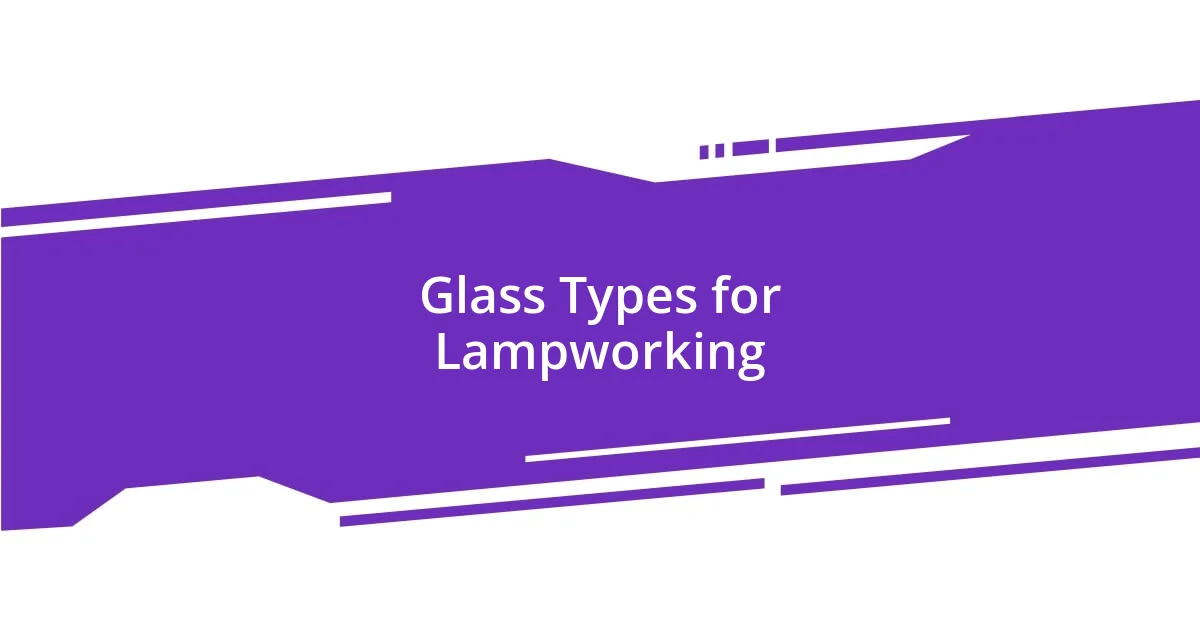
Glass Types for Lampworking
When it comes to lampworking, the type of glass you choose is pivotal. Over the years, I’ve experimented with various glass types, and each one brings its own unique qualities to the table. I still remember my first encounter with soft glass. It was like working with liquid sunshine—its vibrancy and ease of manipulation instantly captivated me. Soft glass is beginner-friendly, melts easily, and is widely available, making it a popular choice for newcomers.
On the other hand, I eventually ventured into hard glass, which, although more challenging, allowed me to create durable and intricate pieces. The transformation from soft to hard glass felt like stepping onto a new playing field. Whether you’re making beads, pendants, or sculptures, the glass type significantly influences your work’s aesthetics and functionality. Here are some glass types I’ve found essential for lampworking:
- Soft Glass: Easier to melt and shape, ideal for beginners and general crafting.
- Borosilicate Glass: More durable and heat-resistant, perfect for intricate sculptures and functional items.
- Fused Glass: Excellent for layering and creating unique textures, often used for artistic embellishments.
- Crystal Glass: Offers exceptional clarity and brilliance, great for higher-end jewelry pieces.
Each glass type has its story, and the more I explore, the more I understand how they can shape my artistic vision. The joy of discovering how different glasses respond to heat and tooling is an adventure in itself.

Safety Gear for Lampworkers
When it comes to safety gear for lampworkers, there’s no room for compromise. I always make sure to wear proper safety glasses intended for high temperatures, as they protect my eyes from harmful UV rays and flying debris. One day, I forgot to put them on during a session, and that moment of carelessness ended with a tiny piece of glass flying my way—never again!
A well-fitted respirator is another non-negotiable piece of safety equipment I swear by. It’s easy to underestimate the fumes emitted when melting glass, but those vapors can be quite hazardous if inhaled. I vividly remember my first lampworking class; I thought I could just use a regular mask. It was uncomfortable and didn’t offer adequate protection, making me realize that investing in a quality respirator is essential—your lungs will thank you!
Lastly, heat-resistant gloves are indispensable. I still recall one of my first projects; I was so eager to touch my beautiful creation that I forgot my gloves. The sharp pang of heat that shot through my fingertips reminded me not just of the importance of safety gear but also of the joy in working carefully and responsibly. How about you—do you prioritize your safety gear while creating? It’s a simple step that can make such a difference in your lampworking journey!
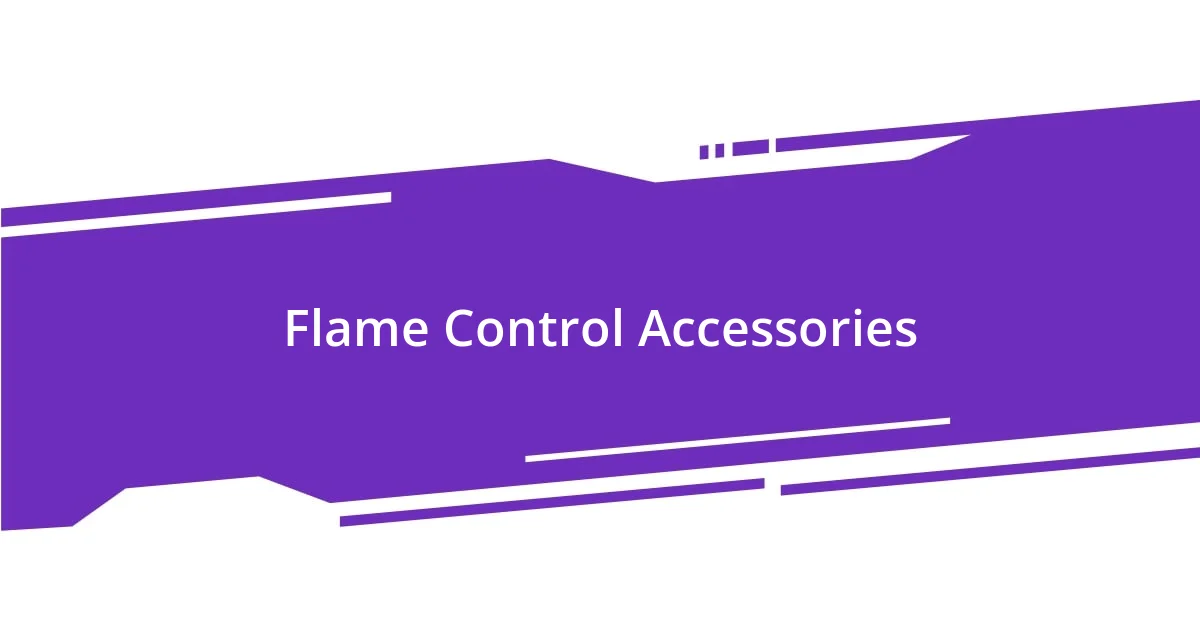
Flame Control Accessories
When it comes to flame control accessories, I can’t stress enough how vital they are for a successful lampworking experience. My go-to tool is the foot pedal, which has truly transformed my approach to working with glass. It allows me to adjust the flame intensity easily, keeping my hands free for delicate tasks. I still remember the excitement I felt the first time I used a foot pedal—suddenly, I was in control of the flame like never before, and the precision I achieved in my work skyrocketed.
Another essential accessory for me is the flame spreader. This little tool is like magic—it helps distribute the flame evenly across the glass, reducing the risk of uneven heating and potential breakage. I vividly recall struggling with a particularly tricky piece, constantly battling with hot spots. Once I incorporated a flame spreader into my setup, my frustration evaporated. It allowed me to focus on creativity rather than damage control. Have you tried using one? If not, I highly recommend experimenting with it.
I also can’t overlook the importance of the right type of torch. I’ve spent a good amount of time evaluating different brands and styles, and each has its own personality. Switching from a basic torch to a more advanced model felt like stepping into the fast lane of lampworking. The difference was immediate—I found that my flame could go hotter and cooler based on my needs effortlessly. This adaptability has opened new doors for my creativity. What’s your flame of choice, and how does it affect your artistic flow? The right accessories can truly amplify your passions and take your lampworking to the next level.
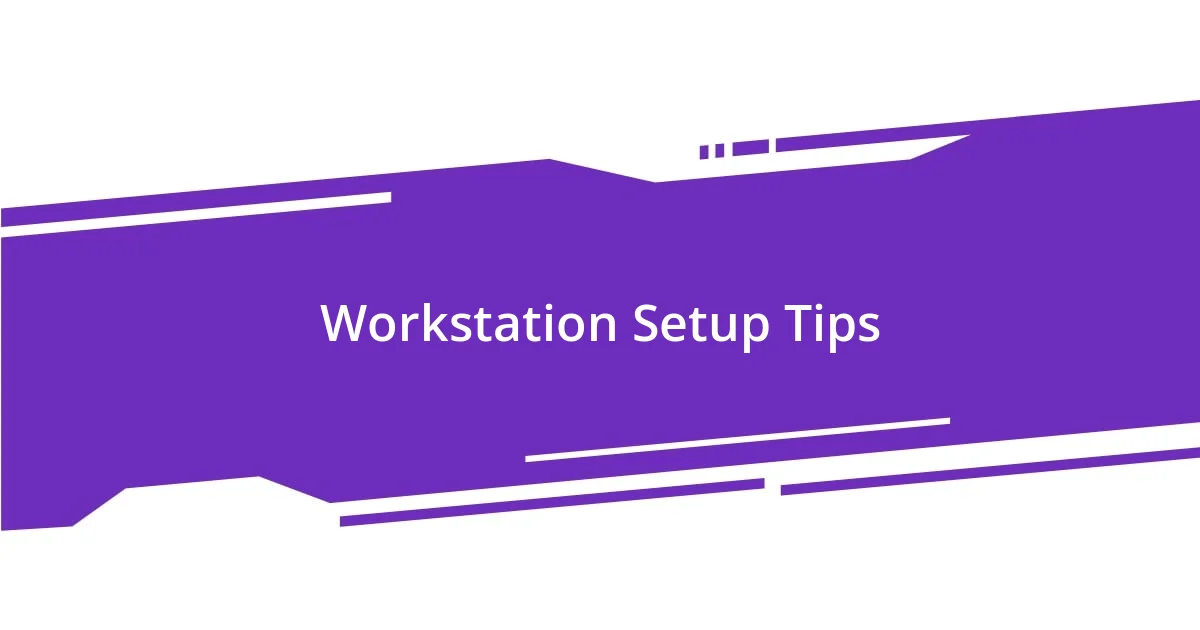
Workstation Setup Tips
Setting up your workstation is crucial for an enjoyable and productive lampworking experience. I remember my early days when I didn’t pay much attention to my layout. I was constantly reaching for supplies and ended up feeling flustered. Now, I make sure everything I need—from tools to glass rods—is within arm’s reach. It truly streamlines my creativity and keeps me in the zone. Have you considered how an organized space can impact your workflow?
Proper lighting is another aspect I’ve learned not to ignore. I’ve had my fair share of frustrating moments due to poor lighting conditions—trying to shape glass when I couldn’t see what I was doing was a headache. I invested in adjustable task lights, which illuminate my workspace and reduce eye strain. The clarity makes all the difference, allowing me to focus on the finer details. What kind of lighting do you use, and how does it influence your work?
Lastly, don’t underestimate the importance of ventilation in your setup. During one of my sessions, I suddenly felt light-headed—turns out, I had neglected the airflow in my workspace. Now, I ensure proper ventilation by working near a window or using a vent fan. It not only keeps the air fresh but also enhances my concentration. What strategies do you use to maintain a safe and comfortable workspace while lampworking? Finding the right balance can elevate your entire experience.

Advanced Accessories for Expert Techniques
When it comes to advanced accessories, my go-to has to be the glass mold. These molds are game-changers, allowing me to create intricate shapes with precision, something I struggled with in the past. I remember the first time I used a mold—I was astonished by how easily I could replicate a complex design. Have you ever felt that rush when you finally nail a technique? It’s exhilarating!
Another accessory I swear by is the marver. This flat surface helps in shaping and cooling glass, and I can’t tell you how often it saves the day. I still have a vivid memory of one late-night session when my glass was on the verge of collapsing. The marver let me salvage the piece, turning a potential disaster into a masterpiece. Doesn’t it feel rewarding to rescue a creation just in the nick of time?
Lastly, I’ve become quite fond of specialized glass cutting tools. These might seem small, but they play a significant role in the precision of my work. I recall a particularly busy week when I had multiple commissions; the cutting tool allowed me to work faster without sacrificing quality. What tools have you found indispensable in your own lampworking journey? The right accessories can truly make a world of difference, enhancing both efficiency and creativity.


